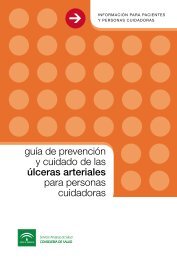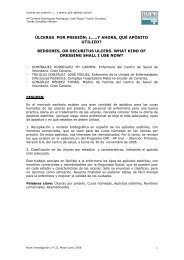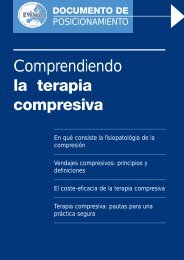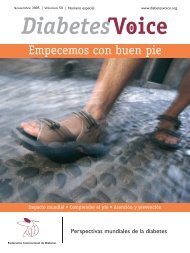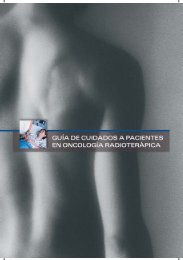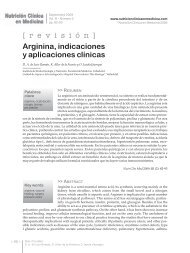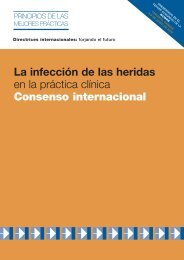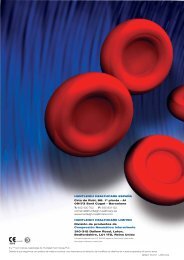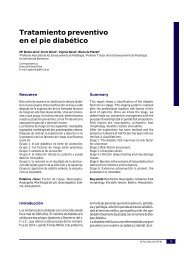Descargar - Úlceras.net
Descargar - Úlceras.net
Descargar - Úlceras.net
- No tags were found...
You also want an ePaper? Increase the reach of your titles
YUMPU automatically turns print PDFs into web optimized ePapers that Google loves.
NEGATIVE PRESSURE WOUND THERAPY IN DIABETIC FOOT WOUNDS ■ 117on dressings removal. Conversely, PU foam isrecommended when a rapid surface granulationresponse is desired, as is the case oflarge, deep, uniformly shaped wounds withfew contours or tunnels (46). Because of thelack of shape memory, gauze may contourbetter the surface of complex-shaped woundsand it is easier to apply than PU foam, whichrequires extensive pre-shaping and can bevery time consuming (46). PVA foam can alsobe used in these complex wounds since it hasmuch less shape memory than PU foam (47).The WCL is used with the purpose ofminimising tissue ingrowth into the woundfiller material and thereby protecting thewound bed from damage during the removalof wound filler and reducing de patient’s pain.It is recommended to use a non-adherentWCL when using a PU foam-based to bolstera skin graft. However, the use of a less adhe -rent filler such as gauze or PVA foam mayremove the need for additional WCL (37).Pressure levelUpon the adoption of commercial NPWT,a standard pressure setting of -125 mmHgbecame the accepted norm. In recent years,the need to modify the pressure settings for avariety of reasons suggested a benefit of arange of negative pressure levels between -40and -150 mmHg instead of a fixed value.Several in vivo studies suggest that pressuresfrom -40 to -80 mmHg are oftenenough to determine wound contraction andthat increasing pressure beyond this pointresulted in little additional contraction (39,40, 48). Other in vivo studies have also consistentlydemonstrated increased blood flow atpressures ranging from -50 to -175 mmHg(49-51).Microdeformation of the wound surfacewas also observed with pressures of -75 and-125 mmHg (40). The effect of varying levelsof pressure on formation of granulation tissuehas been evaluated in two animal studies (4,13) and one clinical study (52). The maximalgranulation tissue formation occurs in therange from -50 to -125 mmHg.The higher level of negative pressure isassociated to increased discomfort expe -rienced by the patient (49) and thereby lowernegative pressures may be considered toreduce pain.Avoidance of higher levels of negativepressure is also recommended in woundswith vascular compromise since NPWTreduces blood flow in immediate vicinity ofthe wound and this effect becomes more pronouncedwith increasing negative pressure(6, 43).On the other hand, when management ofhigh levels of exudate is a specific treatmentgoal, a higher level of negative pressure (withinthe therapeutic range of 50-150 mmHg)may be needed to adequately manage thewound fluid (54).Continuous or intermittent deliveryof pressureIntermittent delivery of pressure, whichinvolves cyclical release and reapplication ofpressure, in a typical pattern of 5 minutes onand 2 minutes off, has been shown to increasethe rate of granulation tissue formation (4,55) compared to continuous pressure.However, intermittent pressure delivery canexacerbate the pain that is experienced bythe patient at every cycle. Furthermore, duringthe off phase, exudate can accumulate andbreak the adhesive film seal. Borquist et al.(55) demonstrated that a «variable» therapyproviding smooth cycles of two different levelsof negative pressure is almost as effectiveas conventional intermittent pressure butpreferable to patients.Drainage conduitNegative pressure may be applied using anon-perforated drainage tube connected tothe top of the dressing or a perforateddrainage tube within the wound filler. Malmsjet al (56) reported that, for «wet» wounds,perforated drains inserted into the woundfiller transmitted negative pressure to thewound bed more efficiently than non-perfo-





